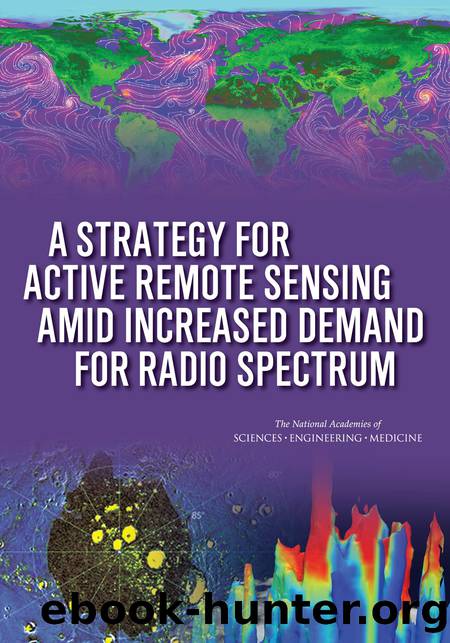A Strategy for Active Remote Sensing Amid Increased Demand for Radio Spectrum by Committee on a Survey of the Active Sensing Uses of the Radio Spectrum

Author:Committee on a Survey of the Active Sensing Uses of the Radio Spectrum
Language: eng
Format: epub
Publisher: The National Academies Press
Published: 2015-10-05T00:00:00+00:00
RADIO SPECTRUM ISSUES
The characteristics of the various space physics active remote sensing instruments vary significantly from instrument to instrument, which means that the spectrum issues also vary significantly. In the VLF band, the instruments use navigation and timing signals generated by others. The band is not heavily used for other purposes, and there are few spectrum issues. While the primary interference signals in the HF band are environmental (cosmic background and terrestrial lightening), increased usage for communication and broadcasting means that at times no clear frequencies are available that can be used by the HF radars. At the UHF and L-bands, crowding of the bands has become a significant problem. The most telling example is the allocation of a band near 900 MHz for telecom use in Finland and Sweden, resulting in the loss of the band for use by the European Incoherent Scatter Radar (EISCAT). Their operations now rely entirely on their VHF system. In the United States, radars operating in the band near 430 MHz share the band with Department of Defense (DOD) radars, which have priority. The PFISR system is allowed to operate at the edge of the band occupied by the DOD radar at Clear Air Force Station, Alaska, but was allowed to do so only after extensive testing showed that it did not interfere with that system. Even at the edge of the band, the PFISR system experiences significant RFI at times.
Future advances in space physics research will rely on increasing spatial and temporal resolution and sensitivity, which will increase bandwidth and power requirements for active remote sensing. To some extent, the future demands are unknown and will be driven by individual investigators proposing new instruments or enhancements to the existing ones.
Download
This site does not store any files on its server. We only index and link to content provided by other sites. Please contact the content providers to delete copyright contents if any and email us, we'll remove relevant links or contents immediately.
Tools of Titans by Timothy Ferriss(8218)
Turbulence by E. J. Noyes(7936)
Secrets of Antigravity Propulsion: Tesla, UFOs, and Classified Aerospace Technology by Ph.D. Paul A. Laviolette(5309)
Astrophysics for People in a Hurry by Neil DeGrasse Tyson(5134)
Room 212 by Kate Stewart(5038)
Design of Trajectory Optimization Approach for Space Maneuver Vehicle Skip Entry Problems by Runqi Chai & Al Savvaris & Antonios Tsourdos & Senchun Chai(5011)
Pale Blue Dot by Carl Sagan(4912)
The David Icke Guide to the Global Conspiracy (and how to end it) by David Icke(4626)
A Journey Through Divination and Astronomy by Publishing Pottermore(4344)
Goodbye Paradise(3728)
Apollo 8 by Jeffrey Kluger(3637)
COSMOS by Carl Sagan(3554)
Losing the Nobel Prize by Brian Keating(3499)
The Five People You Meet in Heaven by Mitch Albom(3475)
How to Read Water: Clues and Patterns from Puddles to the Sea (Natural Navigation) by Tristan Gooley(3409)
Brief Answers to the Big Questions by Stephen Hawking(3369)
How to Read Nature by Tristan Gooley(3249)
The Order of Time by Carlo Rovelli(3145)
A Brief History of Time by Stephen Hawking(2962)
